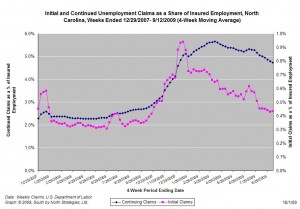Policy Points
04.10.2009
Policy Points
An analysis in today’s issue of The New York Times explains an important, albeit extremely technical aspect, of the latest national employment report: the benchmark revision.
To generate its monthly jobs estimates, the U.S. Bureau of Labor Statistics surveys non-farm employers subject to unemployment insurance taxation (virtually all) and then adjusts those numbers to reflect jobs created or destroyed by new and closing businesses. To verify the survey’s accuracy, the Bureau annually compares its survey data to actual unemployment insurance tax records for the month of March.
Normally, there is very little discrepancy between the two, but this year, a wide gap appears to exist due to less job creation at new firms and more job destruction at closing ones.
Specifically, the revision found that the economy shed 824,000 more jobs between March and 2008 and March 2009 than first reported. This means that jobs losses during the first half of 2008 were occurring at a rate three times greater than the reported one.
Moreover, the now eight million jobs that have been lost since December 2007 are equal to 5.8 percent of all the non-farm jobs that existed in the country prior to the recession. In percentage terms, this is the greatest contraction in employment than has occurred in all but one recession since 1939.
02.10.2009
Policy Points
CHAPEL HILL (October 2, 2009) – National employment numbers released today show that September was the 21st-straight month in which the economy shed more jobs than it added. Another 263,0000 positions were lost, and the unemployment rate hit 9.8 percent.
“There is no good news in the September jobs report,” says John Quinterno, a principal at South by North Strategies, Ltd., a research firm specializing in economic and social policy. “Jobs are disappearing en masse, unemployment is rising, and the share of the population engaged in economically productive activities is dropping.”
Click to read South by North Strategies’ analysis of the latest employment report.
01.10.2009
Policy Points
For the filing week ending on September 19th, 18,046 North Carolinians filed initial claims for unemployment insurance, and 188,402 individuals applied for continuing insurance benefits. Compared to the prior week, both initial and continuing claims were higher. These figures come from data released today by the U.S. Department of Labor.
Averaging new and continuing claims over a four-week period — a process that helps adjust for seasonal fluctuations and better illustrates trends — shows that an average of 17,350 initial claims were filed over the last four weeks, along with an average of 189,656 continuing claims. Both levels were down slightly compared to the previous four-week period.
 The graph shows the changes in unemployment insurance claims (as a share of covered employment) in North Carolina since the recession’s start (12/07).
The graph shows the changes in unemployment insurance claims (as a share of covered employment) in North Carolina since the recession’s start (12/07).
Although new and continuing claims appear to have peaked for this cycle, the claims levels remain elevated and point to a labor market that is quite weak.


 Email Sign-Up
Email Sign-Up RSS Feed
RSS Feed